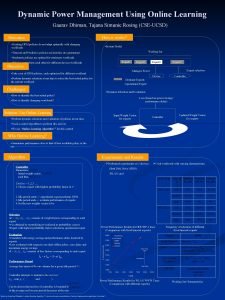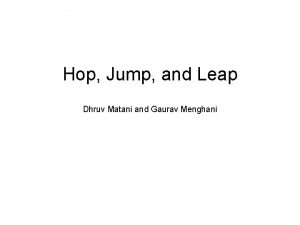Dynamic Power Management Using Online Learning Gaurav Dhiman

- Slides: 1

Dynamic Power Management Using Online Learning Gaurav Dhiman, Tajana Simunic Rosing (CSE-UCSD) How it works? Motivation • Existing DPM policies do not adapt optimally with changing workloads • System Model Working Set • Timeout and Predictive policies are heuristic (no guarantees) • Stochastic policies are optimal for stationary workloads Expert 1 • Policies outperform each other for different devices/workloads Expert 2 ………. Expert 3 Expert. N Objectives Expert selection Manages Power • Take a set of DPM policies, each optimized for different workload Controller Device • Perform dynamic selection at run time to select the best suited policy for the current workload : Dormant Experts : Operational Expert Challenges • Dynamic Selection and Evaluation • How to identify the best suited policy? Loss (based on power savings/ performance delay) • How to identify changing workloads? Solution: Use Online Learning Input Weight Vector for experts • Perform dynamic selection and evaluation of policies at run time Updated Weight Vector for experts Controller • Need a control algorithm to perform this activity • We use ‘Online Learning Algorithm’ 1 for this control Why Online Learning? • Guarantees performance close to that of best available policy in the set Algorithm Experiments and Results ØPerformed experiments on 2 devices: Controller Parameters: Initial weight vector , such that, § Hard Disk Drive (HDD) § WLAN card ØUsed workloads with varying characteristics Trace Type Value of Timeout α Tbe-30 s 30 s-90 s 90 s-180 s Do for t = 1, 2, 3…. . 1. Choose expert with highest probability factor in rt HP-1 Trace 2. Idle period starts -> operational expert performs DPM 3. Idle period ends -> evaluate performance of experts 4. Set the new weights vector to be low 4. 8% 69% 26. 2% medium 32. 3% 65. 4% 2. 3% high 100% 0% 0% low 5. 4% 48. 8% 45. 8% medium 20. 7% 43. 9% 35. 4% high 100% 0% 0% HP-2 Trace Selection • wt = <wt 1, wt 2, …wt. N> consists of weight factors corresponding to each expert • rt is obtained by normalizing wt (referred as probability vector) • Expert with highest probability factor selected as operational expert Power/Performance Results for HDD HP-1 trace (Comparison with fixed timeout experts) Evaluation • Considers both energy savings and performance delay incurred by experts • Loss evaluated with respect to an ideal offline policy: zero delay and maximum energy savings • lt = <lt 1, lt 2, …lt. N> consists of loss factors corresponding to each expert Frequency of selection of different fixed timeout experts Expert Fixed Timeout Performance Bound Average loss incurred by our scheme for a given idle period ‘t’: Can be shown that net loss of controller is bounded by or the average net loss period decreases at the rate Timeout = Tbe Adaptive Timeout Initial timeout = Tbe; Adjustment = +0. 1 Tbe/-0. 2 Tbe lti = α ltie + (1 - α) ltip Controller attempts to minimize the net loss: LG – mini Li ( and ) HDD Power/Performance Results for WLAN WWW Trace (Comparison with different experts) 1 Based on Freund and Schaphire’s online allocation algorithm (“A decision-theoretic generalization of on-line learning and an application to boosting”) Exponential Predictive In+l = a in + (1 – a). In, with a = 0. 5 TISMDP Optimized for delay constraint of 7. 5% Working Set Characteristics

